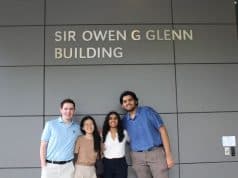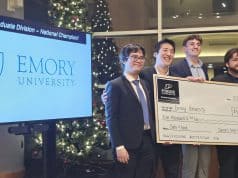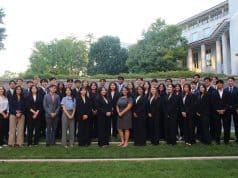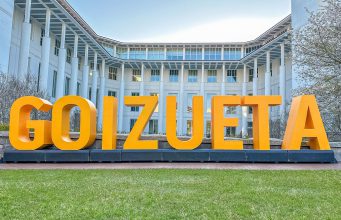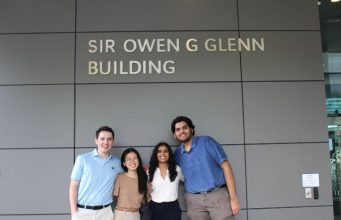Written by William Mann, David Schweidel, and Rajiv Garg
As artificial intelligence (AI) rapidly reshapes the business world, we at Goizueta Business School are intently studying its implications for our many stakeholders. Given the equally rapid pace of change in the AI field, this will be an ongoing and urgent investigation for many years. However, some lessons have already become clear during the early years of this new revolution in technology. We will describe a few of these lessons, and how they are already impacting our strategic initiatives at the school.
A Powerful Tool in the Right Hands
A first lesson is that, despite widespread fears, AI does not have to be a job killer but can instead be a productivity enhancer. When entrepreneurs can rapidly draft contracts and write code, many business opportunities will be created. When researchers can quickly gain insights into consumer behavior, new market segments will be created. In general, when employees need less time for rote tasks and can spend more time on higher-level thinking, that only makes them more valuable, and also makes their time at work more fulfilling. From this perspective, AI could be yet another form of technological progress that ultimately unlocks greater economic growth and a more satisfying career experience.
However, this perspective assumes that workers and managers will know how and when to use AI technology. For them to be in that position, there will be tremendous value in obtaining early career exposure to cutting-edge applications of AI across all domains. Indeed, it seems safe to say that future careers will revolve around recognizing and pursuing opportunities to deploy existing AI technologies to achieve solutions in new settings. This requires creativity, critical thinking, and leadership, all fundamentally human traits that cannot themselves be automated. Higher education is devoted to cultivating all these traits in our students, and our role will be more important than ever as AI literacy becomes a critical skill to future careers throughout the economy.
The Importance of Human Oversight
A second lesson is that, while generative AI is astonishingly fast at producing a solid first draft of any task, it cannot be trusted on its own to achieve production-quality output, cite sources, or explain its reasoning. Organizations that blindly deploy AI-generated content will be quickly noticed by their customers, employees, and other stakeholders, to the detriment of their brands. This means that, while the future of work will include heavy uses of generative AI to get started on difficult tasks, it will also involve extensive checking on the quality of their output, coaching and improving them to perform better, and anticipating the situations in which they can be deployed safely. Professionals will need deep awareness of how these models learn, the mistakes and biases they exhibit, and what nudges might improve their performance.
With these insights in mind, Goizueta Business School is rapidly rolling out a broad array of teaching, research, and administration initiatives that will strategically integrate AI technology into our curriculum and operations.
Building AI Fluency through Experiential Learning
At Goizueta, we have created four dimensions to enhance AI fluency through our curriculum: Foundational knowledge of AI, business applications of AI, technical application development with AI, and societal and ethical implications of AI. We have been reimagining business education to provide fluency in these dimensions with courses across all academic areas. Beyond the classroom, we focus on giving our students hands-on opportunities to utilize AI tools for their daily tasks, recognizing that some skills are best learned through experience and interaction. Our philosophy is that AI must be ubiquitous during the student experience to prepare them for a career in which it will be commonplace. We have to prepare our graduates to be fluent in the use of AI tools for generation or automation, preparing them for their first jobs upon graduation and enabling them to adapt to inevitable future AI developments.
AI as a Teaching Assistant
As one prominent example of our efforts, we have developed a platform for deploying Retrieval Augmented Generation (RAG) based chatbots as virtual teaching assistants for any given course. The system is designed to be agnostic about the course in question: Faculty provide it with the materials that they are willing to share, and it quickly builds a knowledge base that it can use for discussions with students. This system is being rolled out across multiple courses in the fall, with plans for a broader rollout to all interested faculty by the spring semester. In our early testing, the system is remarkably adept at explaining complex concepts, walking through exercises and reviewing problems, and translating course material into foreign languages. Intended future developments include personalizing responses based on students’ level of understanding and using the virtual teaching assistant to follow up on classroom discussions.
With around-the-clock help from a virtual TA available at the push of a button, students will be able to progress more quickly through the foundational material of the course and arrive sooner at the frontier of knowledge where they must grapple with deeper and unsettled questions in their field. At this frontier, chatbots themselves struggle to provide correct answers, and start to exhibit characteristic overconfidence in unreliable answers. This too will be part of the learning experience for students, as we critically examine AI-generated output, and understand why it can exhibit shortcomings when the same tools excel at more basic tasks. In the end, the virtual TA is a way to help students with their knowledge of not only the course material itself, but also the promises and perils of applying AI to that same material.
AI in the Classroom: Grading, Coding and More
We are building AI into the classroom experience along other dimensions as well. A team of Goizueta faculty is piloting an AI grading system this fall. The goal is not for AI to generate the ultimate grades, but rather to give students immediate, preliminary feedback on their projects, highlighting any significant issues that they might want to revisit before submitting. This tool amplifies the student learning experience by allowing students to stretch the limits of their own knowledge and develop deeper insights that will be reliable and robust for decision-making. This is a natural use case for AI in the real world of business, and we feel that it should be embraced in the classroom as well.
Similarly, classes that feature heavy coding will also use AI in the classroom to rapidly prototype code and focus on the concepts being illustrated, rather than the details of syntax or function definitions. Variations on an initial idea can be spun up in moments and constraints on the process can easily be imposed. Students will still need to study and learn the exact syntax behind in-class examples, but this can be done outside of class, again with the help of an AI such as the chatbots described above. While AI-assisted coding cannot replace the programmer, it can serve as a layer of abstraction between the programmer and the hardware, much like a programming language itself. As with all new tools, the future will belong to developers who know when and how to use this new layer of abstraction to their benefit.
Innovators in Business Education
The common theme with these ideas is that AI can allow students and faculty to avoid frustration and pain points and refocus our attention on the engaging and fulfilling work that brought us together in the first place. An equally important theme is that one cannot simply accept AI-generated answers uncritically but must apply critical thinking about its suggestions in order to be effective. This calls for human operators who are more knowledgeable about their fields than ever, making AI a productivity enhancer rather than a job killer.
At Goizueta, we have created many more such initiatives to transform business education and prepare our future workforce for a world in which AI is commoditized. Under the leadership of Dean Gareth James, these opportunities are being explored by a diverse task force of researchers, teachers, and administrators, with members including Rajiv Garg (Information Systems and Operations Management), Wen Gu (Information Systems and Operations Management), Allison Kays (Accounting), William Mann (Finance), Abraham Oshotse (Organizations and Management), David Schweidel (Marketing), Stephanie Adams (Academic Affairs and Instructional Design), and Pam Tipton (Executive Education)
The growth of AI technology has only begun, and the most important applications are yet to be seen. One safe prediction is that our current state of knowledge will be less important in the long run than the ability to study and react to the new ideas arriving over the next few years. We at Goizueta are hungry to know what the future will bring and will continue to position ourselves at the forefront of these impactful emerging trends.
Goizueta faculty apply their expertise and knowledge to solving problems that society—and the world—face. Learn more about faculty research at Goizueta.



